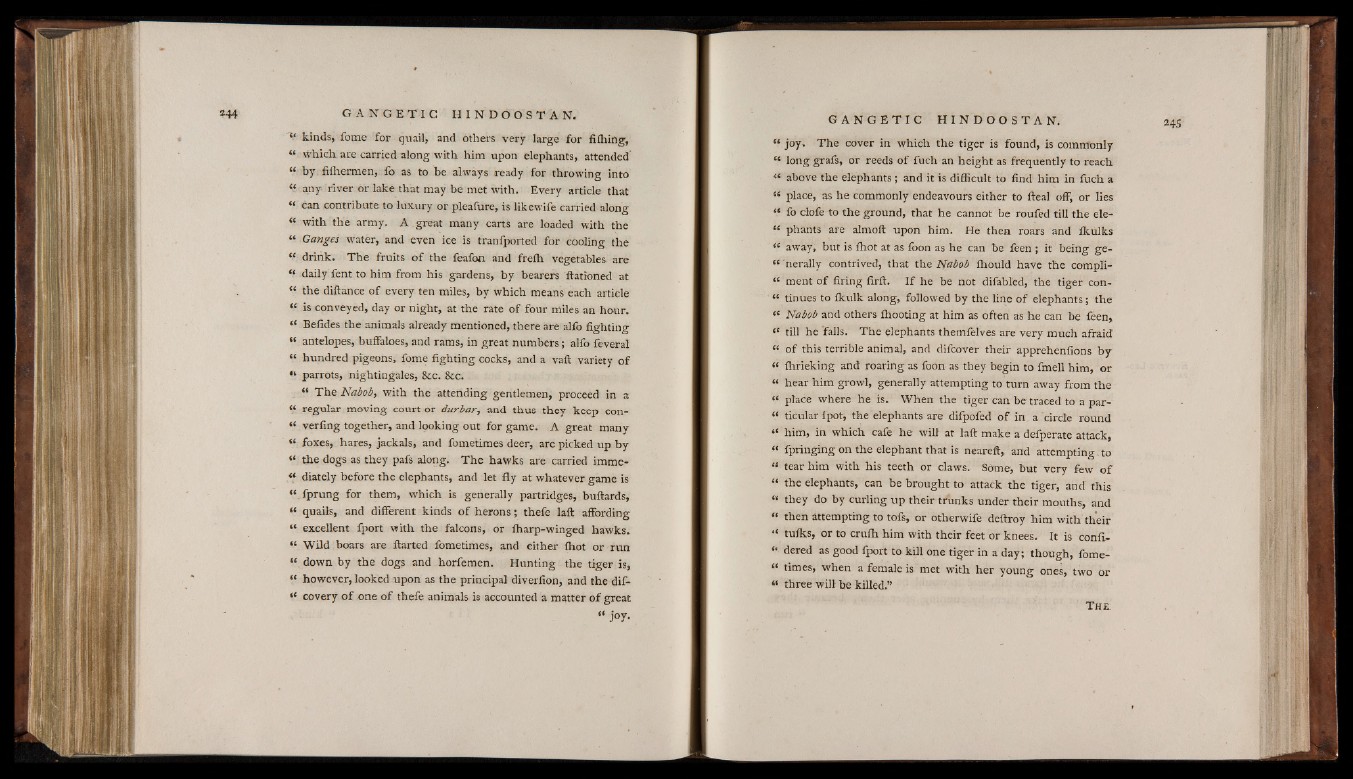
“ kinds, fome for quail, and others very large for fiihing,
“ which are carried along with him upon elephants, attended
“ by fiihermen, fo as to be always ready for throwing into
“ a n y river or lake that may be met with. Every article that
“ can contribute to luxury or pleafure, is likewife carried along
“ with the army. A great many carts are loaded with the
“ Ganges water, and even ice is tranfported for cooling the
“ drink. The fruits o f the feafon and freih vegetables are
“ daily fent to him from his gardens, by bearers ftationed at
“ the diftance o f every ten miles, by which means each article
“ is conveyed, day or night, at the rate of four miles an hour.
“ Befides the animals already mentioned, there are alfo fighting
“ antelopes, buffaloes, and rams, in great numbers; alfo feveral
¥ hundred pigeons, fome fighting cocks, and a vaft variety of
* parrots, nightingales, &c. &c.
“ The Nabob, with the attending gentlemen, proceed in a
“ regular moving court or durbar, and thus they keep con-
% verfing together, and looking out for game. A great many
“ foxes, hares, jackals, and fometimes deer, are picked up by
“ the dogs as they pafs along. The hawks are carried imme-
“ diately before the elephants, and let fly at whatever game is
“ fprung for them, which is generally partridges, buftards,
“ quails, and different kinds of herons; thefe laft affording
“ excellent fport with the falcons, or iharp-winged hawks.
“ Wild boars are ftarted fometimes, and either ihot or run
“ down by the dogs and horfemen. Hunting the tiger is,
“ however, looked upon as the principal diverfion, and the dif-
“ covery o f one of thefe animals is accounted a matter of great
“ j°y-
G A N G E T I C H I N D O O S T A N . 24s
joy. The cover in which the tiger is found, is commonly
long grafs, or reeds o f fuch an height as frequently to reach
above the elephants; and it is difficult to find him in fuch a
place, as he commonly endeavours either to fteal off, or lies
fo clofe to the ground, that he cannot be roufed till the elephants
are almoft upon him. He then roars and ikulks
away, but is ihot at as foon as he can be feen; it being generally
contrived, that the Nabob fhould have the compliment
of firing firft. I f he be not difabled, the tiger continues
to ikulk along, followed by the line of elephants; the
Nabob and others ihooting at him as often as he can be feen,
till he ‘falls. The elephants themfelves are very much afraid
o f this terrible animal, and difcover their apprehenfions by
ihrieking and roaring as foon as they begin to fmell him, or
hear him growl, generally attempting to turn away from the
place where he is. When the tiger can be traced to a particular
fpot, the elephants are difpofed o f in a circle round
him, in which cafe he will at laft make a defperate attack,
fpringing on the elephant that is neareft, and attempting , to
tear him with his teeth or claws. Some, but very few o f
the elephants, can be brought to attack the tiger, and this
they do by curling up their trunks under their mouths, and
then attempting to tofs, or otherwife deftroy him with their
tuiks, or to cruih him with their feet or knees. It is confi-
dered as good fport to kill one tiger in a day; though, fometimes,
when a female is met with her young ones, two or
three will be killed.”